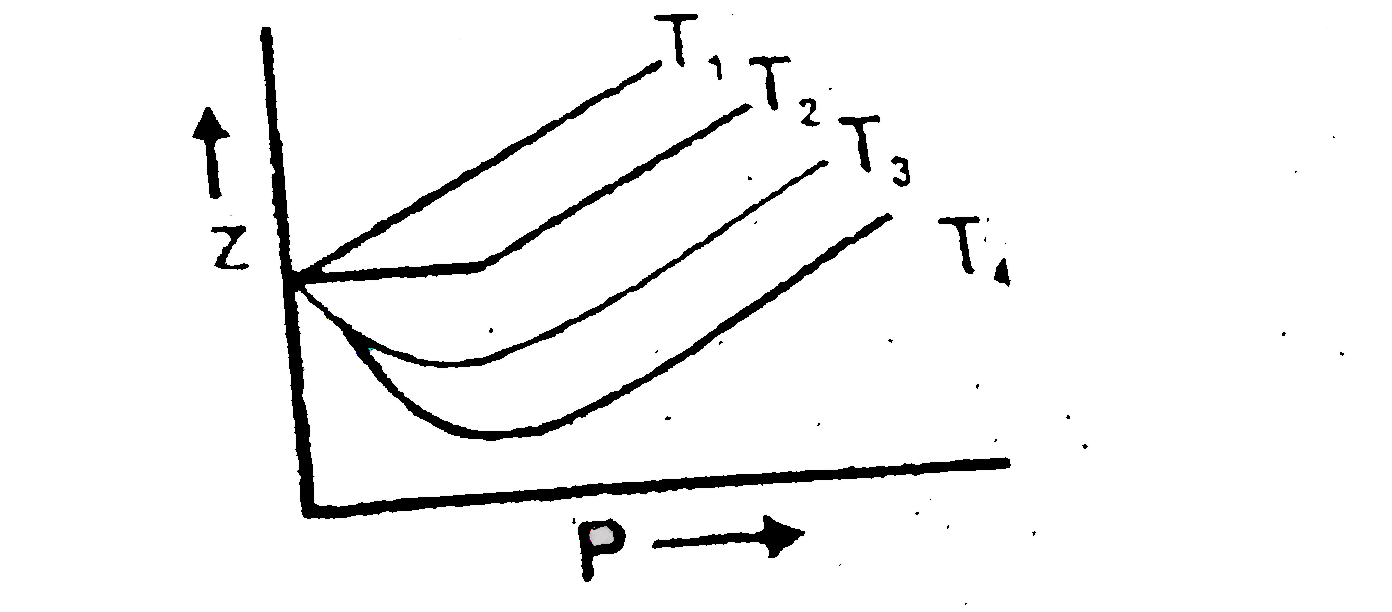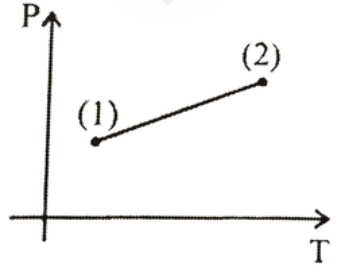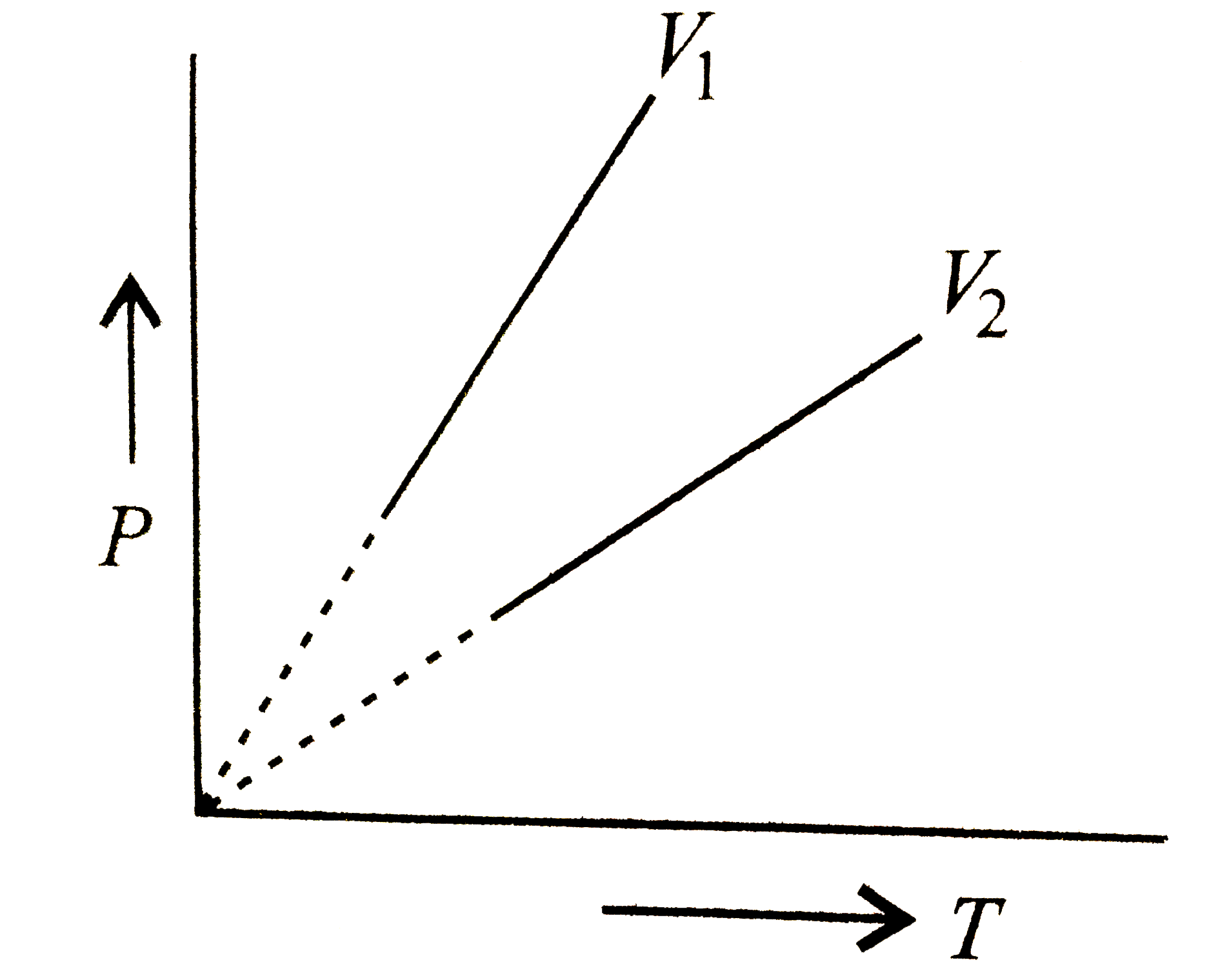When a sample of ideal gas is changed from an initial state to a final state, various curves can be plotted for the process like P-V curve, V-T curve,P-T curve etc.
For example, P-V curve for a fixed amount of an ideal gas at constant temperature is a rectangular hyperbola, V-T curve for a fixed amount of an ideal gas at constant volume is again a straight line. However, the shapes may vary if the constant parameters are also changed.
Now, answer the following questions :
Two Vander waals gases have same value 'b' but different 'a' value then which of the following statement is correct under simialr condition .
Both gases will occupy same volume
Gas having a larger value of a will occupy lesser volume
Gas having a larger value of a will occupy larger volume
Can not be predicted
The correct Answer is:B
To solve the question regarding two Van der Waals gases with the same value of 'b' but different values of 'a', we will analyze the implications of these parameters in the Van der Waals equation.
1. Understand the Van der Waals Equation:
The Van der Waals equation is given by:
(P+an2V2)(V−nB)=nRT
Here, 'P' is pressure, 'V' is volume, 'n' is the number of moles, 'R' is the universal gas constant, 'T' is temperature, 'a' is a measure of the attraction between gas molecules, and 'b' is the volume occupied by the gas molecules themselves (repulsive forces).
2. Identify the Parameters:
- Given that both gases have the same value of 'b', it implies that the volume correction due to repulsion is the same for both gases.
- The different values of 'a' indicate that the attraction forces between the molecules of the two gases are different.
3. Analyze the Effect of 'a' on Volume:
- A larger value of 'a' means stronger intermolecular attractions. According to the Van der Waals equation, as the attraction between molecules increases (higher 'a'), the effective volume available for the gas molecules to move in decreases.
- Thus, a gas with a larger 'a' will occupy a smaller volume compared to a gas with a smaller 'a', assuming all other conditions (temperature, pressure, number of moles) are the same.
4. Evaluate the Statements:
- Statement A: "Both gases will occupy the same volume." This is incorrect because the gas with a larger 'a' will occupy a smaller volume.
- Statement B: "Gas having a large value of 'a' will occupy lesser volume." This is correct as explained above.
- Statement C: "Gas having a large value of 'a' will occupy more volume." This is incorrect, as it contradicts the relationship between 'a' and volume.
- Statement D: "It cannot be predicted." This is also incorrect since we can predict the volume based on the values of 'a' and 'b'.
5. Conclusion:
The correct statement is Statement B: "Gas having a large value of 'a' will occupy lesser volume."
The Van der Waals equation is given by:
(P+an2V2)(V−nB)=nRT
Here, 'P' is pressure, 'V' is volume, 'n' is the number of moles, 'R' is the universal gas constant, 'T' is temperature, 'a' is a measure of the attraction between gas molecules, and 'b' is the volume occupied by the gas molecules themselves (repulsive forces).
- Given that both gases have the same value of 'b', it implies that the volume correction due to repulsion is the same for both gases.
- The different values of 'a' indicate that the attraction forces between the molecules of the two gases are different.
- A larger value of 'a' means stronger intermolecular attractions. According to the Van der Waals equation, as the attraction between molecules increases (higher 'a'), the effective volume available for the gas molecules to move in decreases.
- Thus, a gas with a larger 'a' will occupy a smaller volume compared to a gas with a smaller 'a', assuming all other conditions (temperature, pressure, number of moles) are the same.
- Statement A: "Both gases will occupy the same volume." This is incorrect because the gas with a larger 'a' will occupy a smaller volume.
- Statement B: "Gas having a large value of 'a' will occupy lesser volume." This is correct as explained above.
- Statement C: "Gas having a large value of 'a' will occupy more volume." This is incorrect, as it contradicts the relationship between 'a' and volume.
- Statement D: "It cannot be predicted." This is also incorrect since we can predict the volume based on the values of 'a' and 'b'.
The correct statement is Statement B: "Gas having a large value of 'a' will occupy lesser volume."
Topper's Solved these Questions
Similar Questions
When a sample of ideal gas is changed from an initial state to a final state, various curves can be plotted for the process like P-V curve, V-T curve,P-T curve etc.
For example, P-V curve for a fixed amount of an ideal gas at constant temperature is a rectangular hyperbola, V-T curve for a fixed amount of an ideal gas at constant volume is again a straight line. However, the shapes may vary if the constant parameters are also changed.
Now, answer the following questions :
From the given plot between Z and P for a real gas the correct is :

View SolutionWhen a sample of ideal gas is changed from an initial state to a final state, various curves can be plotted for the process like P-V curve, V-T curve,P-T curve etc.
For example, P-V curve for a fixed amount of an ideal gas at constant temperature is a rectangular hyperbola, V-T curve for a fixed amount of an ideal gas at constant volume is again a straight line. However, the shapes may vary if the constant parameters are also changed.
Now, answer the following questions :
Which of the following graphs is not possible for a fixed amount of ideal gas upon moving from initial state A to final state B :
View SolutionWhen a sample of ideal gas is changed from an initial state to a final state, various curves can be plotted for the process like P-V curve, V-T curve,P-T curve etc.
For example, P-V curve for a fixed amount of an ideal gas at constant temperature is a rectangular hyperbola, V-T curve for a fixed amount of an ideal gas at constant volume is again a straight line. However, the shapes may vary if the constant parameters are also changed.
Now, answer the following questions :
Two moles of an ideal gas is changed from its initial state (16 atm, 6L) to final state (4 atm, 15L) in such a way that this change can be represented by a straight line in P-V curve.The maximum temperature attained by the gas during the above change is :(Take : R=112LatmK−1mol−1)
View SolutionWhich of the following curve is correct for a given amount of an ideal gas at constant pressure?
View SolutionWhat is the shape of the curve obtained on plotting P against PV at constant temperature for an ideal gas ?
View SolutionWhich of the following curve is correct for an ideal gas ?
View SolutionFigure shows a process for a given amount of an ideal gas. If volume in state 1 is V1 & in state 2 is V2, then

View SolutionA plot of P vs T for a given mass of gas at constant volume is a straight line . P vs T at constant volumes V1 and V2 for an ideal gas are shown below :
Which of the following is correct ?

View Solution1mol of a gas is changed from its initial state (15L,2atm) to final state (4L,10atm). If this change can be represented by a straight line in P−V curve, calculate the maximum temperature that, the gas attained.

View SolutionFor an ideal gas V−T curves at constant pressure P1 & P2 are shown in figure, from the figure
_E01_061_Q01.png)
View Solution
